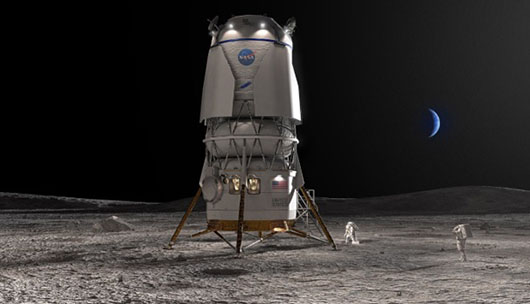Special to CosmicTribune.com, May 23, 2023
By Richard Fisher
As long as the nation can afford it, redundancy in spacecraft adds to the assurance that the United States can build a presence on the Moon sufficient to deter predations from the Chinese Communist Party’s hegemonic ambitions to control the Earth-Moon System.
So, despite a dense U.S. news cycle, it was noteworthy that on May 19, 2023 the National Aeronautics and Space Administration (NASA) announced its selection of a third space launch vehicle (SLV) and Moon lander architecture for reaching and populating the Moon.

First, NASA has its Space Launch System (SLS) space launch vehicle and Orion manned spaceship, with the potential to loft 50 tons to the Moon, that cost $23.8 billion from 2011 to its first successful 25-day Artemis-1 unmanned mission around the Moon in November 2022.
Then in 2020, NASA evaluated three proposals for its manned Human Landing System system, with the intention to select two for demonstration purposes, Option A and Option B, from proposals made by the SpaceX Corporation, a team led by Blue Origin and a proposal from the Dynetics Corporation.
Then in April 2021 NASA selected billionaire Elon Musk’s SpaceX Corporation’s potential 100 tons to the Moon Starship to form the basis of its Human Landing System (HLS), a reusable spacecraft to dock with Orion in Lunar Orbit and then take people and cargo to the Moon and back to Lunar Orbit.
SpaceX’s HLS proposal received $2.89 billion, with an additional $1.15 billion in 2022, to deliver an unmanned demonstration flight to the Moon and then a manned flight as part of the Artemis-III first manned Moon mission in 2025.
The 220 -ton, 9-meter diameter Starship second stage will first launch to Low Earth Orbit (LEO) where it will be refueled by four to six Starship fuel cargo missions, before going to Lunar Orbit to dock with Orion for the transfer of astronauts that then descend to the Moon.
Then after billionaire Jeff Bezos’ Blue Origin lost its attempt to contest in court the selection of SpaceX for the HLS, NASA revived the Option B plan, renaming it the Sustaining Lunar Development (SLD) program.
NASA’s strategy was to foster competition in the delivery of Moon access services while leveraging investments from the private sector.
Then on May 19, NASA announced its selection for the SLD, a team led by Blue Origin and including Lockheed Martin, Boeing, Draper, Astrobotic and Honeybee Robotics.
They will receive an initial $3.4 billion contract, that with an expected $3+ billion investment by Bezos, will result in a manned Moon lander to support the Artemis-V mission planned for 2029.
Called Blue Moon, the Blue Origin Moon lander shows considerable evolution from its 2020 proposal; It is a single-stage, reusable 45-ton fully fueled, 16-ton unfueled craft that is 16 meters tall and designed to fit into the Blue Origin 7-meter diameter 45-ton to LEO New Glenn SLV, though the first mission may use the SLS.
Whereas the 2020 proposal had the crew module on top, the latest Blue Moon concept shows the 4-passenger or 20-ton cargo module on the bottom of the stack, and a hydrogen-oxygen fuel system on the top of the stack, presumably to better enable Lunar orbit fueling.
Full Text . . . . Current Edition . . . . Subscription Information

You must be logged in to post a comment Login